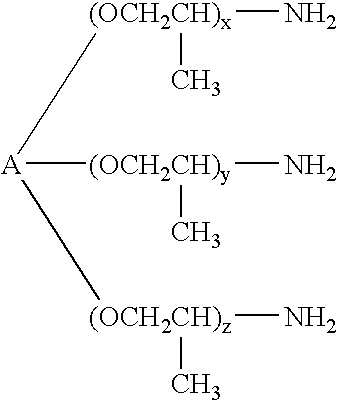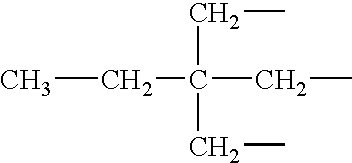Epoxy adhesive having improved impact resistance
a technology of epoxy adhesives and adhesives, which is applied in the direction of adhesive types, organic non-macromolecular adhesives, cellulose adhesives, etc., can solve the problems of significant problems in the preparation of high impact, expandable adhesives, and significant problems in the preparation of epoxy based adhesives, so as to improve impact toughness and/or impact resistance
- Summary
- Abstract
- Description
- Claims
- Application Information
AI Technical Summary
Benefits of technology
Problems solved by technology
Method used
Image
Examples
example 1
Preparation of Epoxy-Based Prepolymer SF 65
[0081]The reaction products of linear and trifunctional ATPPG with DGEBA can be prepared 5 separately or in the mixture. Epoxy-based prepolymers A to J were prepared from the following constituents, the formulation size being 1 kg in each case:
[0082]
Preparation of Epoxy-Based Prepolymers (in equivalents)EEWAHEWABCDEFGHJliquid1870.7650.7650.7650.7650.690.765—1.785—DGEBAsemisolid255——————1.122—1.122DGEBAsolid4750.7650.7650.7650.7650.692————DGEBAsolid537—————0.266———DGEBACTBN3250.170.170.170.17——0.147——adductCTBN 190*—————0.125——0.125adductDimeric650————0.34————fattyacid / epoxyresinadductLinear10000.440.430.440.430.43————ATPPGLinear500—————0.3340.2860.2380.334ATPPGtrifunct.5000.080.023——0.013——0.048—ATPPGtrifunct.75——0.0110.023—————ATPPGViscosity at 80° C. [Pa · s]3637283334176.30.597.8*5% CTBN, 95% DGEBA
[0083]The epoxy resins were melted at approximately 80° C. and introduced first into the kneader by means of a delivery screw, then the addit...
example 2
Preparation of the Acrylate Terminated Urethane Resin
[0093]The NCO-reactive components (polyols) are mixed for 45 min at 90-100° C. and 0.1-2 mbar to remove water. The polyisocyanate is then added in one portion under nitrogen at 50° C. The reaction mixture is mixed under nitrogen at 70-80° C. to a constant NCO-value. Then the NCO-reactive acrylate is added together with a polymerization inhibitor. Dibutyltin dilaurate (0.01%) is added after 1 hour at 80° C. and the mixing is continued for additional 2 h, then the epoxy resin is added.
[0094]
WeightinWeightChemical name ofTradenameComponentgramspercentcomponentof CompanyAcrylate Terminated Urethane Resin A:CAPA 30527510.7PolycaprolactoneSolvayPolyolInteroxCAPA 22067226.2PolycaprolactoneSolvayPolyolInteroxMDI53821.0Methylenediphenyldi-isocyanateHPMA31012.1HydroxypropylmethacrylateEPON 82876930.0DGEBAResolutionPerformanceProductsAcylate Terminated Urethane Resin B:PTHF 65039239.0PolytetrahydrofuranMDI22522.4Methylenediphenyldi-isocyanat...
example 3
Preparation of the Curable Adhesive
[0095]Curable adhesives are prepared by admixing SF-65 with an acrylate-terminated urethane resin and other components listed in Table 1 below with mixing for 45 minutes at a temperature controlled between 27-38 degrees C. (80-100 degrees F.) and pressure of 0.3-3 psi.
[0096]
TABLE 1(all amounts stated are in grams)Component / Adhesive123456789101112SF-65 A (Example 1)500500500500SF-65 B (Example 1)500SF-65 C (Example 1)500SF-65 D (Example 1)500SF-65 E (Example 1)500SF-65 F (Example 1)500SF-65 G (Example 1)500SF-65 H (Example 1)500SF-65 J (Example 1) 500Polydis 3604EPON 828100100100100100100100100100100100100EPON 834DER 351100100100100100100100100100100100100DER 354Resin A (Example 2)100Resin B (Example 2)100Resin C (Example 2)100Resin D (Example 2)Resin E (Example 2)Resin F (Example 2)Resin G (Example 2)Resin H (Example 2)Resin J (Example 2)100100100100100100100100100Resin K (Example 2)Resin L (Example 2)Resin M (Example 2)Resin N (Example 2)AMICURE C...
PUM
| Property | Measurement | Unit |
|---|---|---|
| temperatures | aaaaa | aaaaa |
| temperature | aaaaa | aaaaa |
| temperature | aaaaa | aaaaa |
Abstract
Description
Claims
Application Information
 Login to View More
Login to View More - R&D
- Intellectual Property
- Life Sciences
- Materials
- Tech Scout
- Unparalleled Data Quality
- Higher Quality Content
- 60% Fewer Hallucinations
Browse by: Latest US Patents, China's latest patents, Technical Efficacy Thesaurus, Application Domain, Technology Topic, Popular Technical Reports.
© 2025 PatSnap. All rights reserved.Legal|Privacy policy|Modern Slavery Act Transparency Statement|Sitemap|About US| Contact US: help@patsnap.com



